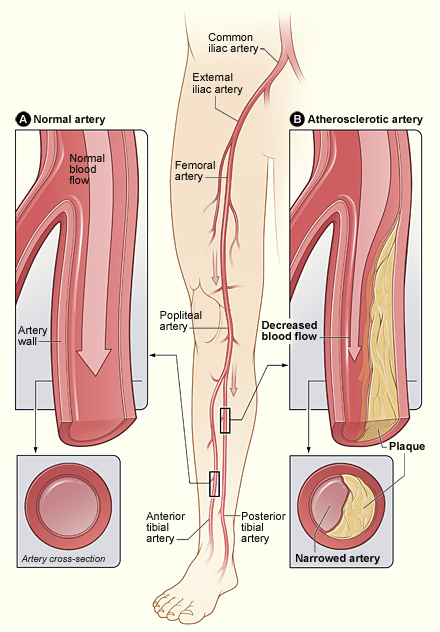Angiography
Angiography is a medical imaging technique used to visualize the inside of blood vessels and organs of the body, with particular interest in the arteries, veins and the heart. This is traditionally done by injecting a radio-opaque contrast agent into the blood vessel and imaging using X-ray based techniques such as fluoroscopy. Angiography is used to diagnose blockages and other blood vessel problems.
One specific type called a peripheral angiogram is used to help your doctor find narrowed or blocked areas in one or more of the arteries that supply blood to your legs. This condition is known as Peripheral Artery Disease.

Procedure
The peripheral angiogram is performed in a hospital or outpatient clinic.
- Before the test, a nurse will put an IV (intravenous line) into a vein in your arm so you can get medicine (sedative) to help you relax. You’ll be awake during the test.
- A nurse will clean and shave the area where the doctor will be working. This is usually an artery in your groin.
- A local anesthetic will be given to numb the needle puncture site.
- The doctor will make a needle puncture through your skin and into your artery, and insert a long, thin tube called a catheter into the artery. You may feel some pressure, but you shouldn’t feel any pain.
- The doctor will inject a small amount of dye into the catheter. This makes the narrowed or blocked sections of your arteries show up clearly on X-rays. The dye may cause you to feel flushed or hot for a few seconds.
- A peripheral angiogram usually takes 1 to 3 hours from the time you arrive until the catheter is removed.
Complications
Complications from angiography may include bleeding, pain, or swelling where the catheter was inserted, or pain, numbness, or coolness in your arm or leg. These symptoms may signify either bleeding from the puncture site or blockage of your artery. Bruising at the puncture site is common and usually resolves on its own. Rarely, impaired kidney function, or kidney failure, can occur following an angiogram, especially if you already have kidney disease. Also rarely, severe allergic reactions can occur, especially among people who have had previous allergic reactions to the contrast dye. Infrequently, a patient may experience shortness of breath or fluid overload if they have a heart condition associated with poor pumping action, such as congestive heart failure.
